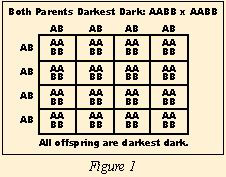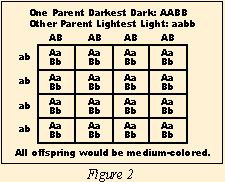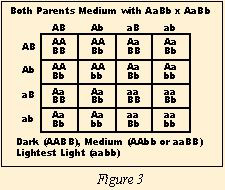The explanation of the origin of “races” is given by simple genetic principles. (For those of you who freaked out in high school biology, hang in there! I will try my best to make this understandable. Geneticists, please bear with the simplification!) All right, here we go!
Our “looks” are determined by genes. Genes coding for a particular trait (like skin color) can come in a variety of forms called “alleles.” Sometimes these alleles appear to be of equal strength, and a blending of the trait is found in the offspring. Often, however, one of these alleles is “stronger” than another. The “stronger” allele is called “dominant,” the “weaker” is called “recessive.” Genes coding for dominant characteristics are usually expressed in a shorthand abbreviation as a capital letter (e.g. A or B), while recessives are expressed by a corresponding lower case letter (e.g. a. or b).
Now, how does all this relate to skin color and the question of the origin of races? Although various factors moderate and impact skin tones, skin color is primarily determined by the amount and distribution of the pigment, melanin, which is present in the skin.
Melanin comes in two different forms, controlled by different alleles. For simplicity here, we will designate them A and a, B and b. Darkness is determined by the number of dominant alleles in the offspring. Thus, if the genetic combination turns out to be AABB, skin color would be darkest dark. If it is AaBa, skin color is medium. If it is aabb, skin color would be lightest light.
Geneticists use a chart called a “Punnett Square” to illustrate the way in which these alleles can be distributed during sexual reproduction. The Punnett Square basically shows all the possible ways in which dominant and recessive alleles from father and mother can combine in their offspring. It gives a simplified way of predicting statistically what to expect as shown in the illustrations.
 Now let’s explore what could happen when reproduction takes place. Note the 3 examples in Figures 1, 2, and 3. In Figure 1, we see what happens if both parents have the genes necessary to produce the darkest dark skin color (AABB). Their offspring could inherit ONLY “A” or “B” varieties of the genes (not “a” or “b”). Hence, all of their children would be very dark. Likewise, if two parents had the “aabb” combination (not illustrated), their offspring could inherit ONLY “a” or “b” and all of them would be very light.
Now let’s explore what could happen when reproduction takes place. Note the 3 examples in Figures 1, 2, and 3. In Figure 1, we see what happens if both parents have the genes necessary to produce the darkest dark skin color (AABB). Their offspring could inherit ONLY “A” or “B” varieties of the genes (not “a” or “b”). Hence, all of their children would be very dark. Likewise, if two parents had the “aabb” combination (not illustrated), their offspring could inherit ONLY “a” or “b” and all of them would be very light.
Figure 2 shows what happens when one parent is very dark and the other very light. All children will have medium skin color.

Things get very interesting if both parents have the AaBb combination, though. Figure 3 shows the possible combinations for their children. These two medium-skinned parents could have children with skin colors ranging all the way from darkest dark to lightest light – in one family, in one generation! It doesn’t take millions of years or differing ancestry. It only takes the right combination of genes to begin with.
 So why do some populations seem to have most people someplace in the middle? One way would be if the founders of a population both had the AABB combination. Their children would then all be of the AABB skin type. The situation would be similar if two parents with aaBB got together. All of their children would be of the aaBB type. (Homework assignment: Make your own Punnett Squares to illustrate various combinations to see what would happen.)
So why do some populations seem to have most people someplace in the middle? One way would be if the founders of a population both had the AABB combination. Their children would then all be of the AABB skin type. The situation would be similar if two parents with aaBB got together. All of their children would be of the aaBB type. (Homework assignment: Make your own Punnett Squares to illustrate various combinations to see what would happen.)
Using the principles above, we could infer that both Adam and Eve probably had types AaBb, which gives the greatest possible variation in their children. It is likely that there was quite a genetic mixture among the human population, up through the time of the Flood until the Tower of Babel. After that, as family groups spread out due to the confusion of languages, certain skin colorations might have become “set” within a family (or tribe) due to inbreeding.
Isn’t it fun to see how modern science continues to confirm and shed light on the Truth of God’s Word? His Word and His World agree!
For more information, read The Answers Book, Of One Blood, and Darwin’s Plantation (all by Ken Ham); and Creation: The Facts of Life (by Dr. Gary Parker).
Originally published in the September/October 2008 issue of Think & Believe newsletter. Please call our office or email us at [email protected] for additional resources on these subjects.


